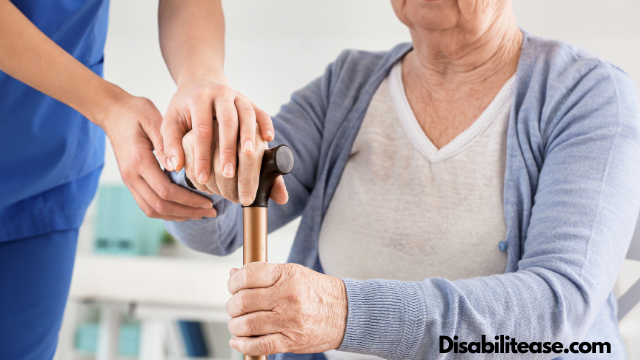What Does Parkinson’s Disease Do? Parkinson’s Disease is an idiopathic condition that affects physical and mental abilities. The condition is incurable and progresses slowly over the years with more than 5 different stages of severity.

Most of the symptoms are caused by a reduction in dopamine due to the loss of nerve cells in the brain. Dopamine is essential for maintaining healthy movement of the body and muscle coordination.
The deficiency also leads to mood swings and emotional irregularities. The cause of nerve cell reduction is still unclear, but most likely causes may include environmental and genetic factors.
We have a related article for you, you can read Best Computers, Tablets, And Mouses For Parkinson’s Patients.
Table of Contents
What Does Parkinson’s Disease Do? How Parkinson’s Affects Daily Life?
Affected individuals struggle to utilize a complete range of motion within their muscles. The condition makes muscles stiff and rigid, making everyday activities difficult.
Advanced stages can cause severe physical disability, making an independent lifestyle impossible. Early signs include sudden shaking, tremors, balancing, and cognitive problems.
Parkinson’s Disease usually appears in the form of distinct stages with varying symptoms. The Disease also progresses very slowly, making differentiation of severity and treatment easier. The five main stages of the Disease include:
Stage 1: Affected individuals show minimal symptoms, including mild tremors, shaking, and a dull posture. The day-to-day tasks such as walking, cleaning, and working are not disturbed at this stage.
Stage 2: The early symptoms of stage 1 become more noticeable, and patients start to face difficulty in walking, balancing, and carrying out speech.
One’s posture also becomes duller at this stage, and going through intensive workdays becomes a challenge. The progress from stage 1 to this stage can take years to develop.
Stage 3: Everyday balance, walking, and tasks become highly challenging at this stage. While the individual may remain independent, they start to require support for more complicated tasks such as walking up a staircase or carrying weight.
Stage 4: This is when falling becomes a serious risk making independent living impossible. Patients usually require more therapy and medication to manage their symptoms.
Support from family and other associations becomes necessary as affected individuals usually cannot work to make a living at this stage.
Stage 5: This stage is accompanied by multiple physical disabilities, and patients usually need a wheelchair to remain mobile.
One’s mental and neurological state also deteriorates severely, making communication difficult. Nearly 40 percent of people at this stage report delusions and hallucinations.
Life Expectancy
While Parkinson’s Disease can cause severe mental and physical disabilities, modern medicine has made it more manageable. The average life expectancy of individuals with Parkinson’s Disease is similar to any other normal person.
The condition is not directly fatal, but it can cause other complications that can become life-threatening. Patients are at a higher risk of developing other problematic conditions such as arthritis, infections, and depression.
A recent study of 219 people with Parkinson’s Disease showed that more than 45 percent of patients died from Pneumonia. The condition can therefore lead to lower life expectancy indirectly.
Another common cause of death in affected individuals is falling and balance-related injuries. Since the condition puts great strain on the body and makes walking or standing difficult, people often struggle to keep their balance while carrying out the simplest tasks.
The American Parkinson’s Disease Association reports that along with direct death from falling, patients also die due to complications arising from surgeries conducted to treat the fall-related injuries.
Diagnosis
Despite years of research, scientists are still unsure of its causes. The Disease is classified as idiopathic – with no clear relationship to potential influencing factors.
Moreover, due to its subjective nature and no biological signs, it can’t be diagnosed with any tests, including blood tests, X-rays, or MRI scans. The symptoms commonly occur in multiple other conditions, including depression, arthritis, and anemia. This makes the absolute diagnosis less possible.

General practitioners usually refer to a patient’s and their family’s medical history to assess the possibility. Specialists may prescribe certain medications to see how one’s body reacts to them.
This is currently the most valid diagnosis. If a person’s symptoms improve after taking a medication called Levodopa, they most likely have Parkinson’s Disease. The diagnosis is also accompanied by various other tests, such as MRI or CT scans to rule out the possibility of any other neurological condition.
Potential Causes
A clear cause is still unknown, but multiple studies show evidence for the role of environmental and genetic factors. It is also believed that an interaction of both factors is a more likely cause than one factor alone.
Genetic Factors
Parkinson’s Disease can arise due to a mutation within the essential gene known as LRRK2. The gene is responsible for producing a protein necessary to carry out multiple cell functions.
The defect causes disturbance within the cell machinery responsible for the breakdown of unwanted protein. When the protein is not degraded properly, its accumulation causes the death of essential nerve cells within the brain.
Along with the LRRK2 gene, many other gene defects can cause complications. A mutation in the genes PARK7, SNCA, PRKN, Or PINK1 can also cause the Disease. However, these are rarer than LRRK2 mutations. And, it is estimated that only less than 10 percent of total Parkinson’s disease cases are due to genetic factors.
Environmental Factors
Exposure to certain toxins can make people more susceptible to the Disease. However, a direct link has still not been found.
Most studies show that the condition appears many years after the first exposure, making correlation quite difficult. Also, most commonly suspected factors include pesticides, heavy metals, viruses, and bacteria exposure.
Environmental factors are more influential in causing already genetically susceptible individuals to develop the condition rather than as a direct cause.
Treatments
Most people respond very well to Parkinson’s medication which minimizes the impact of symptoms on their daily life. Most early stages require minimal intervention and can be improved with physiotherapy and oral medication. Some of the common treatments include:
Occupational therapy
Occupational therapists help individuals maintain their independence by providing practical solutions for carrying out everyday tasks. It also involves rearranging the amenities, workspace, and necessities within the house to make them more accessible.
Oral Medication
- Levodopa
Levodopa is the most popular treatment choice for controlling sudden shaking and tremors. The drug works by releasing dopamine within the brain which helps patients maintain their muscle coordination and balancing abilities.
Most movement problems such as walking, cleaning, and working can be greatly improved with continual medication. However, its efficacy becomes low as the disease progresses into the advanced stages.
The medication is then either replaced or given in higher doses to compensate for the more rapidly deteriorating nerve cells. In some cases, it is given along with dopamine agonists to prevent over-reliance on one drug.
The medication also comes with side effects that are mostly related to physical stability. Multiple studies have found a correlation between long-term use and jerky movements and sudden (but momentary) immobility.
- Dopamine Agonists
Sometimes dopamine agonists are taken simultaneously as Levodopa, as this allows lower doses of Levodopa to be used.
Dopamine Agonists are similar to Levodopa but act as a substitute for dopamine rather than releasing original dopamine within the brain. It has more lasting efficacy and is therefore given in less frequent doses.
While longer-lasting, the improvement is relatively low compared to Levodopa. For this reason, it is never prescribed as the first and primary treatment but only as a supplement to Levodopa.
The medication also carries multiple side effects, including frequent sickness, sleepiness, and dizziness. Many patients also report unusual spikes in compulsive behavior such as compulsive shopping, addictive gambling, and hypersexuality.
Monoamine oxidase-B Inhibitors
Monoamine oxidase-B Inhibitors (MOA-B) work by maintaining high dopamine levels naturally present within the brain.
Monoamine Oxidase-B is an enzyme that breaks down dopamine within the brain. MOA-B blocks this enzyme from functioning, allowing more dopamine to accumulate within the brain. However, they are usually prescribed during the early stages of Parkinson’s Disease due to their low efficacy.
They are often given alongside levodopa or dopamine agonists to prevent excessive side effects from the over-reliance on one medication. These inhibitors are very well tolerated by the body and do not cause any serious side effects compared to other medications.
Catechol-O-methyltransferase Inhibitors
Catechol-O-methyltransferase (COMT) inhibitors are a more appropriate medication for those at advanced stages of the disease.
These prevent the breakdown of Levodopa, which is naturally done by an enzyme present in the brain. COMT helps maintain higher levels of Levodopa by blocking this enzyme from attacking it.
Conclusion
While Parkinson’s is a highly progressive disease, modern medication has made it more manageable.
Also, make sure to check out my post on Best 12 Board Games And Puzzles For Parkinson’s Patients.
Advanced stages are also rare, and most people never face serious disabilities. The progression to stage 2 alone takes 5 years, making stage 5 only possible after 11 to 12 years.

Hi, my name is Eddie, I am a professional trainer specializing in the elderly population and I’m also a website designer. I love training in the gym, going to the beach, traveling, and having good food.
I combined my love for sport and website designing to make “DisabilitEase” whose purpose is to help elderly and disabled people live a more full and active life, have more fun, and enjoy their unique journey despite any disability.


